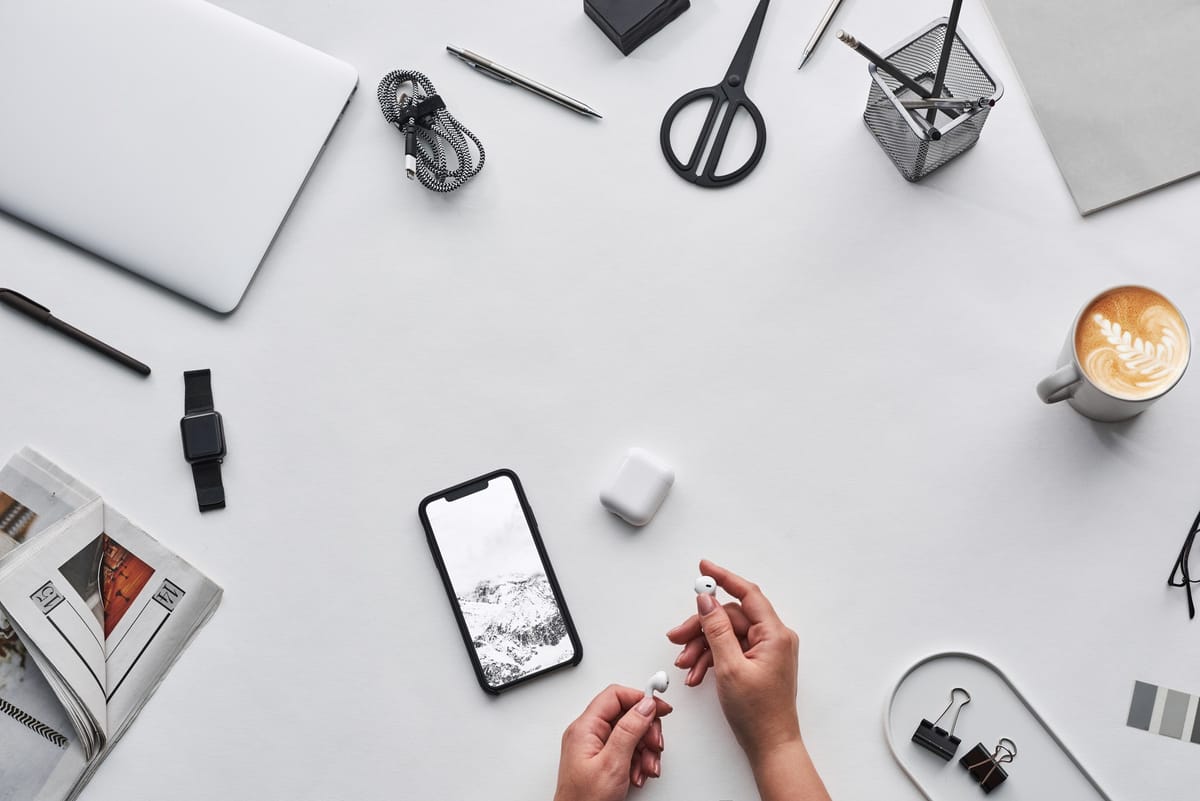Productivity | Fantastic Tools I'm Using Recently
Available in English, Japanese/日本語 and Chinese/中文.

🇬🇧Subscribe if you would like to try to read in 3 languages!
🇯🇵日本語版はこちらをクリック、又は下にスクロールしてください!よかったら、サイトの「Subscription」フォームに登録して、無料のEメールサブスクリプションよろしくお願いいたします。
🇨🇳中文版请点击此处跳转,或参见本页下方。欢迎填写邮件订阅表格,免费订阅。
In the past few months, I began to concentrate on self-improvement, especially on productivity tools. I found my perfect productivity system with these tools and I cannot wait to share with you.
Today I'm just going to share the list of the tools. I'll try to share the scenarios when I use each tool shortly, so stay tuned.
💡Background Knowledge
➡️ What kind of productivity tools do I need?
Considerations:
- For adults, the most important thing to keep working on things is to have a clearly defined purpose (why do it)
- To ensure that you stick to it, another important factor is rewarding
Frankly speaking, I might not be a self-disciplined person (medium level). In the past (just a few years ago), if anyone talked to me about long-term goals and continuous efforts, my first reaction would be "I won't make it." This is very tricky. But now I think the point is commit to yourself and complete the tasks you defined.
On 1st consideration point, I'm using Notion to organize ideas, define my goals, and break them down into habits. Then use the scheduling and task-management apps for time management and habit-tracking. When you encounter learning needs, use note-taking apps.
For 2nd point, when choosing a habit-tracking app, try to choose products that can realize higher-level automatic identification and have certain rewarding functions, and at the same time I bought proper hardware products to motivate myself.
Continue reading for details. 👇👇👇
📱app tools
1️⃣Notion
- One-sentence: Perfect for goal setting, note-taking, and re-organizating knowledge structure; plenty of tutorials and templates provided on the internet
- Use platform: Use on all platforms (sync)
- Cost: Free registration, Pro plan available
I have applied for an account since Notion appeared, but I didn’t explore much on how to use it. Recently, when I watched some self-improvement YouTubers, some tutorials for Notion were recommanded to me. I was somehow inspired by those videos, and did some research.
You can get a lot of videos when you search for Notion in YouTube.
If you are like me and want to find a better, more convenient, and more extensible tool for organizing knowledge points and ideas, try Notion.
Scenarios for me to use Notion: brainstorming + goal-setting & break-down, save and organize favorite magazine images (limitations on storage), save recipes, and memo my thoughts and inspirations.
*It's collaboration function also looks very powerful, but I have been using it by myself as of now. *🐶
2️⃣Google Calendar
- One sentence: The best schedule management when using gmail as the main email account
- Use platform: use on all platforms (use the web version for editing on Mac, use iCalendar to subscribe to Google Calendar)
- Cost: Free
Having used various calendar management apps (including paid ones), I recommended Calendar 5 in the past, and I still think it is a good choice.
The biggest reason for me to go back to google calendar is the powerful functionalities on scheduling, and the lack of reason to use one single app to manage both schedules and tasks.
I have completely moved all my ToDos to 2do, which is synchronized with iOS Reminders. By using google calender, I can better access and edit my reservations on various platforms and devices.
When using gmail, which has almost unlimited capacity, as your main mailbox for communication, the invitations sent by the others can be easily added to your schedule.
It is also a great fun to create a new schedule group to manage individual tasks.
In short, schedule management is very important when it comes to productivity improvement. Completely free Google Calendar is good enough.
3️⃣2do
- One sentence: project management, list management, beautiful interface, sync with iOS tasks
- Use platform: All platforms are synchronized
- Cost: Free to use, some advanced functions need to be paid (I choose to pay)
Combined with Spark, the world is invincible. It's worth paying.
4️⃣Spark
- One sentence: Task-based management of emails, smart mailbox function, can be combined with task management tools including iOS reminders, Todoist, 2do and other apps (I especially like it to collaborate with 2do app)
- Use platform: All platforms
- Cost: Free
Spark is already well-known.
I have also tried many other email management apps. For me, the most important check points for any app are: whether the interface is nice or not, whether the interaction design is user-friendly, whether it can be painful, and cost-effective. Spark almost did it all.
I use this app on all platforms to manage my mail. The combination of the aforementioned and various task management apps is the biggest highlight (many other mailbox management does not support 2do, maybe my preference is a bit unpopular), the next few points, honestly speaking, other excellent mailbox management apps are basically also It can be realized: flexible customized menus when sliding left and right of a single mail, smart mailbox function, custom quick reply, and quick appending of the reservation in the mail to the calendar.
5️⃣Streaks
- One-sentence: Rich interface color options; can track to establish habits and quit habits; multiple track methods: by number of times, by duration, directly linking with Health data; data can also be exported for analysis.
- Use platform: iOS, Watch OS
- Cost: Pay
This app can be used to track your habits, track durations, and analyze your own behavior patterns. It gives you a all-golden view when all the check-in tasks in a page are completed! Cute🐶
6️⃣Goodnote 5
- One sentence: Typesetting, editing, and interface design are the best of all the note-taking tools I have come across
- Use platform: iPad OS/ Mac OS
- Cost: Pay
It is often compared with notability. I think that apart from not being able to record, all other functions Goodnote 5 has, and even better.
Previously, for the recording function, I used two apps at the same time. End of the day, I found that it is almost impossible to listen back to a recording of longer than 1 hour, and it will only take up storage space in the end. As long as you are not a student, the so-called recorded notes are just psychological satisfaction.
The popular Digital Planner on Insta also uses Goodnote, and its custom template function allows users to play a lot.
💻 Hardware tools
7️⃣iPad Air 4 with Apple Pencil (no keyboard)
- One sentence: Large screen, good chip, portable and lower price than iPad Pro, larger screen than iPad Mini, suitable for reading magazines, pictures, and handwriting
It was a hard decision for me between iPad Pro M1 and Macbook Pro for a long time. I have used iPad Pro 1 before because it was too big. Later, when considering keyboard input and using various website functions, sometimes the iPad still has some limitations, so I finally entered the macbook.
Then I carefully analyzed my requirements. What I want from a iPad is as follows -
- Easier to carry + touch screen (Macbook Pro only will not be enough)
- Large screen (no iPad mini)
- iOS synchronization (Android products excluded)
- Handwriting (Requires Apple Pencil)
- The biggest demand is to read magazines, pictures, handwritten notes and draw mind maps under the premise of having a touch screen. The processor is not demanding
- No need for large-capacity storage (Have a Macbook Pro with large storage)
- No keyboard required (actually, I rarely use iPad to type)
- No cellular data required
Then the 64G Wi-fi version of iPad Air 4 + Apple pencil is the perfect match. Now my iPad Air completely met my expectations. I don't even think about the M1 iPad Pro anymore.
8️⃣Kindle Oasis
- One-sentence: Bigger than paperwhite and waterproof (not panicking when reading a book when taking a bath)
Using an iPad when reading plain text is definitely distracting. So in the end, I returned to Kindle (I used to have paperwhite in Shanghai, but sold it before I moved to Japan).
Buying Oasis might be a bit over-killing as it is not more cost-effective than paperwhite. Of course, the larger screen size is, the better reading experience. In addition, the shell feels much better when you hold it in your hand, and the side button is an advantage when reading with single hand.
Waterproof sounds good, but the possibility of falling into the water when taking a bath at home should be infinitely close to zero.
For me, it is a product that I don't regret buying. But not necessarily for everyone.
9️⃣Macbook Pro M1
- One-sentence: The chip is powerful, there is no stress when processing anything; the keyboard of mac is the best; the touch bar is more useful than expected; it integrates the resources of all iOS devices
16G memory and 1TB hard drive, might be slightly over-killing as of now, but considering the increasing application scenarios and smaller storage space I chose for iOS devices, I made my choice.
Actually using Macbook as a hub, whether it is integrating and organizing archived files in iOS devices, or handling some personal affairs, it is very smooth for me.
(For me, the photos stored on the iPhone will actually have a lot of scraps. I found syncing or large storage space is actually meaningless. I'm take advantage of the opportunity to organize it on a Macbook regular basis.)
The sidecar function with iPad is also a plus point.
Forgot my Apple Watch😅, but I won’t go into details. Thanks for reading till the end.
過去2か月間、きっかけがあって、プロダクティビティツールの研究に始めました。おかげで毎日充実しています。
今日は私が今使っているもののいくつかをリストアップします。今後、各ツールの使うシナリオや詳細の使い方について詳しく共有していきたいと思いますので、よろしくお願いいたします。
💡背景
➡️私にどのようなプロダクティビティツールシステムが必要なのか
前提:
1.大人にとって、何かの目標を持つことに最も重要なことは明確な目的を持つこと(なぜそれをやるのか)
2.持続性を保つため、もう1つの重要な要素はリワード
私はストイックな人とは言えない(中レベルくらいかな)。過去(ほんの数年前)、誰かに長期的な目標や継続的な取り組みみたいなことを言われたら、最初に思うのは大体「私には難しい」だった。これは非常にトリッキー。でも今は思うのは、一番大事なことは自分にコミットメントして、自分が定義したタスクを粛々と遂行していくこと。
では上記の1点目をミートさせるために、まずやりたいことのアイデアを整理し、目標を明確にする。その後習慣(ハビットレベル)にブレイクダウン。次に、時間管理とトラッキングにスケジュールアプリとハビットトラッキングやタスク管理アプリを活用。習い事がある場合は、メモを取るアプリを使用。
上記の2つ目について、ハビットトラッキングアプリを選択するときは、よりの自動的にデータを読み込んでトラッキングできることと、ある程度のリワード機能が備えられ、同時に適切なハードウェアを投下し、モチベーションを上げるようにしてきた。
それでは、現在使っているツールを下記詳しく説明! 👇👇👇
📱アプリ系
1️⃣Notion
- 一言評価:目標設定、メモ、知識構造の組み合わせに追いて完璧。たくさんの有識者より豊富なチュートリアルとテンプレートも助かる。
- プラットフォーム:すべてのプラットフォームで使用(同期機能)
- コスト:無料登録、ファイルサイズに応じてプロプラン有(私は個人のProプランをサブスク)
Notionが登場してからアカウントを申請したが、詳しく研究していなかった。最近、自己啓発系のユーチューバーにハマって、YouTubeがNotionのチュートリアルが勧められた。それらの動画を見て興味が湧いてきて、改めて使ってみたら、やはりすばらしいと思った。
YouTubeでNotionを検索することをオススメ。
知識のポイントやアイデアを整理するためのより良い、より便利で、より拡張可能なツールを見つけたい場合は、Notionを試すべき。
私Notionを使うシーン:目標を設定する際のブレーンストーミングと内訳、お気に入りの雑誌の画像の保存と整理(容量制限にご留意)、レシピを保存し、自分の考えを記録し、インスピレーション。
コラボレーション機能も非常にパワフルに見えるが、とりあえずスタンドアロン版で使っている。 🐶
2️⃣Googleカレンダー
- 一言評価:Gmailをメインのメールとして使用する場合、最適なスケジュール管理ツール
- プラットフォーム:すべてのプラットフォームで使用(Macでの編集にはWebバージョンを使用し、表示時にiCalendarにGoogleアカウントを追加)
- コスト:無料
有料アプリも含め、いろいろなカレンダー管理アプリを使ってきた。以前Calendar5も良かった。
Googleカレンダーに戻った最大の理由は、スケジュール管理の一元化。ToDoをiOSと同期している2doに完全に移行したし、Googleカレンダーを使用することで、さまざまなプラットフォームやデバイスで予約にアクセスして編集することができる。
さらに、容量がほぼ無制限のGmailをメインの通信メールボックスとして使用すると、相手のメールで送信された予約を簡単にスケジュールに追加できる。
一日の日程をブレイクダウンするための新しいグループスケジュールを作成することも非常に楽しい(使い方は今後詳細説明)。
プロダクティビティを向上させるには、スケジュール管理は非常に重要。そして、完全無料のGoogleカレンダーで十分。
3️⃣2do
- 一言評価:プロジェクト管理、リスト管理、美しいインターフェース、iOSタスクと同期
- プラットフォーム:すべてのプラットフォームで同期
- コスト:無料で使用、一部の高度な機能は有料(有料版利用中)
言うことなく、Sparkと組み合わせると、無敵。料金を払う価値がある。
4️⃣Spark
- 一言評価:メールのタスクベースの管理、スマートメールボックス機能、iOSリマインダー、Todoist、2do、その他のアプリなどのタスク管理ツールと組み合わせることができる(特に、タスクとして2doにメールを共有するのがうれしい)
- プラットフォーム:すべてのプラットフォーム
- コスト:無料
このアプリはすでに有名。
他にもたくさんのメール管理アプリを試した。個人的な意見だけど、どのアプリでも最も重要な評価ポイントは、インターフェースが美しいかどうか、インタラクションデザインが使いやすいかどうか、面倒で費用対効果が高いかどうか。Sparkはほぼ全部クリアと言えるでしょう。
メールを管理するために、このアプリをすべてのプラットフォームにインストールした。さまざまなタスク管理アプリの組み合わせが最大の魅力(他の多くのメールボックス管理は2doをサポートしないのが多いようで、私の好みは少しニッチかも)。
他には、正直言って、他の優れたメールボックス管理アプリも基本的にそれです実現することができる:メールの左右にスライドするときのカスタムメニューは柔軟に設定、スマートメールボックス機能、カスタムクイック返信、およびメール内の予約のカレンダーへのクイック追加等。
5️⃣Streaks
- 一言評価:豊富なインターフェースカラーマッチングオプション。追跡して習慣を構築し、習慣を終了することができる。追跡方法は豊富:回数でカウントまたや時間でカウント、直接ヘルスデータを読み取ったり、データをエクスポートして分析したりすることができる。
- プラットフォーム:iOS、Watch OS
- コスト:有料版有
これ一つのアプリで習慣のトラッキングだけでなく、使った時間の追跡や自分の行動パターンの分析ができる。一画面内のすべてのタスクが完了すると、金色に変わってくれるのでリワード感があり、うれしい🐶
6️⃣Goodnote 5
- 一言評価:メニューの設計、編集、インターフェイスデザインは、私が出会ったすべてのメモ取りツールの中で最高だと思う。
- プラットフォーム:iPad OS / Mac OS
- コスト:有料
GoodnoteはしばしばNotabilityと比較されるよう。録音できないことは別として、他のすべての機能は、Goodnote 5は持っているか、よりよくできていると思う。
以前は、録音機能を使うため、両方を同時に使用していた。結局、1時間以上の録音を聞き直すことはほぼ無理だし、結局ストレージを使ってしまうだけ。学生でない限り、録音メモはただ心理的な満足。(個人的な感想です)
- Instaで人気のDigitalPlannerもGoodnoteを使うことが多いようで、カスタムテンプレート機能によりは楽しく使えるでしょう。 *
💻ハードウェア系
7️⃣iPad Air 4とApple Pencil(キーボードなし)
- 一言評価:大画面、優れたチップ、ポータブルでiPad Proよりも低価格、iPad Miniよりも大画面、雑誌、写真、手書きの落書きを読むのに適している
元々iPad Pro M1とMacbook Proで長い間悩んでいた。以前、iPad Pro 1を持っていたが、サイズ感が大きすぎたので、手放しした。つい最近まで、いろいろ悩んだ結果、Macbookを入手。
しばらく落ち着いて、自分のニーズを分析してみた。
- 持ち運びが簡単+タッチスクリーン(Macbook Proだけで対応できない)
- 大画面(iPad miniは対応できない)
- iOS同期(Android製品でないこと)
- 手書き(Apple Pencilが必要)
- 最大のニーズは、タッチスクリーンを前提として雑誌、写真、手書きのメモを読み、マインドマップを描くこと。最新のチップはいらない。
- 大容量ストレージ必要なし(大容量Macbook Proを持っているため)
- キーボード必要なし(実際、iPadを使って真剣にタイプすることはめったにない)
- セルラーデータ必要なし
よって、iPad Air 4 + Apple Pencilで、64G、Wi-fiバージョンが最もコスパ良い選択肢。実際に購入したところ、期待通りだった。もうM1のiPadProは結構(笑)。
8️⃣Kindle Oasis
- 一言評価:ペーパーホワイトよりも大きく、防水性(入浴時に本を読んでも平気)
単純な文章を読むときにiPadを使用すると、間違いなく気が散る。それで結局、Kindleに戻った(昔上海でpaperwhiteを持っていたが、日本に引っ越す前に手放しした)。
Oasisは若干やりすぎ感があるかもしれない。何故ならば、間違いなくpaperwhiteと比べてコスパは劣れるでしょう。
ただし、画面サイズは少しでも大きいければそれなりに良さがある。さらに、ボディの手触りがはるかに良く、ページめくりボタンで片手で読むときに利点がある。
防水性は良いように聞こえるけど、実際自宅で入浴するときに水に落ちる可能性は限りなくゼロに近いでしょう。
私にとっては、購入して悔がない商品。しかし、すべての人にとって必ずそうでもないかな。
9️⃣MacbookPro M1
- 一言評価:最強なチップ、何をやってもストレスなし。Macのキーボードは最高。タッチバーは予想以上に便利。私はすべてのiOSデバイスのファイルをMacで整理している。
16Gメモリと1TBストレージ容量は、またすこしやりすぎ感があるかもしれない。ただし、他のiOS系デバイスは比較的小さい容量のものを選んだことと、今後のことを考えて、こちらの購入。
今はMacbookをハブとして使用している。アップル同士なので、当たり前だけど、iOSデバイスの資料やファイルをにMacに統合して整理するとき、非常にスムーズ。私自身にもMacで整理する工程は自分の好みに合っている気がする。
(たぶん私だけかもしれないけど、iPhoneに保存されている写真には実際にはたくさんのゴミデータがある。無差別に同期することや、大きな容量を購入することもあまり意味がない。逆に定期的にMacbookで整理すると、写真をより効果的に管理できる気がする。ーー個人的な感想です。)
あとは、iPadとコラボして、サイドカー機能をプラスしたら、もう完璧。
Apple Watchを忘れました。😅今回は割愛します。
最近这两个月来因为一些契机开始潜心钻研生产力工具。充实度增加了不是一星半点。每一个工具背后有各种各样的想法和用法支持,很很多心得可以分享。不过今天先罗列出我现在在用的一些东西,可以看作是提纲。以后分步分享关于每一个工具背后的细节。
💡背景
➡️ 我需要什么样的生产力工具系统
思考前提:
- 对成年人来说,要坚持什么,最重要的是目的明确(为什么干)
- 要保证持续,另一个重要因素是reward(回报)
我可能不能算一个特别自律的人(自律程度中等)。过去,(就在几年以前)谁要是跟我说长期目标、持续努力这类的字眼,我第一反应就是“做不到”。这就很难办了。但现在我认为,重要的不是这种定性的评价,而是对自己做出承诺,并一个个的完成自己定义的任务。
为了实现第一条,使用Notion整理思路,明确目标,同时break-down到习惯(Habit层面)。然后使用日程和任务类app进行时间管理和打卡。遇到有学习类需求的时候,使用笔记类app。为了满足第二条,选择打卡类app的时候,尽可能选择能实现较高级别自动识别和带有一定自我表扬功能的产品,同时搭配上适合的硬件,给自己用它们的动力。
想看现在在用哪些工具,请继续阅读。👇👇👇
📱app工具类
1️⃣Notion
- 一句话评价:灵活的使用方式完美实现目标设定、笔记、知识结构梳理;各种大牛提供的丰富的教程和模版研究起来也很快乐
- 使用平台:全平台使用(同步功能)
- 费用:免费注册,根据文件大小有Pro plan可供选择(我选择付费)
从Notion开始出现就申请过账号,不过当时并没有理解如何活用这个工具,最近看一些self-improvement的博主时,油管给我推荐了一些Notion的tutorial,看了以后受到一些启发,然后实际研究起来发现,简直是个大宝藏。
油管搜索Notion,能得到非常多视频。可以搜搜看。不方便访问的话B站应该也有不少。
如果你和我一样,想寻找更好、更方便、更可扩展的整理知识点和思路的工具,静下心来试试Notion。我用它做的事情:目标设定时的brainstorming + breakdown,保存和整理喜欢的杂志图(注意容量限制,最终因为这个我选择了付费……),保存食谱,记录自己的感想和灵感。
它的协作功能看起来也很强大,不过我暂时一直在单机版使用。🐶
2️⃣Google Calendar
- 一句话评价:使用gmail作为主要邮件时最好的日程管理没有之一
- 使用平台:全平台使用(Mac上使用Web版编辑,查看时使用iCalendar订阅Google Calendar)
- 费用:免费
我使用过各种日历管理app,包括付费类。过去我也推荐过Calendar 5,到现在依然认为它是个不错的选择。
回归Google最大的理由是强大的日程编辑功能,以及不再需要用一个app来同时管理日程和任务。ToDo我已全面移交2do,而后者是与iOS同步的。回头通过使用google calender,我能更好的在各种平台各种设备上访问、编辑自己的预定。
使用容量几乎无限制的gmail作为自己的主要邮箱沟通时,对方邮件发来的预定可以很方便的添加到自己的日程里。
新建一个新的日程组来管理个人task也是一大乐趣(作用以后详述)。
总之,日程管理在提高生产力这个话题下非常重要。而我认为完全免费的Google Calendar已经足够好。国内使用不方便的情况下,依然推荐Calendar 5。
3️⃣2do
- 一句话评价:项目管理,清单管理,界面漂亮,与iOS任务同步
- 使用平台:全平台同步
- 费用:可免费使用,部分高级功能需要付费(我选择付费)
没什么好说的,和Spark结合,天下无敌。付点费用很值。
4️⃣Spark
- 一句话评价:将邮件进行任务式管理,smart邮箱功能,可以与包括iOS提醒、Todoist、2do等各种app在内的任务管理工具结合(我尤其看中它将邮件共享到2do作为任务的功能)
- 使用平台:全平台
- 费用:免费
这个app很多地方推荐过。
同样试过很多其他邮件管理app,任何app对我来说最重要的评测点都是:界面美观与否、交互设计是否人性化、能否戳到痛处、性价比。Spark可以说几乎都做到了。
我在所有平台上都安装了这个app管理自己的邮件。前面提到的和各种任务管理类app相结合是最大亮点(很多其他邮箱管理不支持2do,可能我的喜好有些冷门吧),其后几个有点,老实说其他优秀的邮箱管理app基本也都能实现:单个邮件左滑和右滑时的自定义菜单很丰富,smart邮箱功能、自定义快捷回复、快速将邮件中的预定追加到日程表。
5️⃣Streaks
- 一句话评价:丰富的界面配色选项;可track建立习惯和戒掉习惯;Track的方式丰富:分次数、按时间、直接读取Health数据;还可以数据导出进行分析。
- 使用平台:iOS、Watch OS
- 费用:付费
这一个app可以用来打卡、track自己的耗时、分析自己的行为模式。一个页面中所有打卡任务都完成时还能变金色的!可爱🐶
6️⃣Goodnote 5
- 一句话评价:排版方式、编辑方式、界面设计,是我接触到的所有笔记工具中最优秀的
- 使用平台:iPad OS/ Mac OS
- 费用:付费
常被拿来和notability比较。我认为除了不能录音,其他所有功能都是人无我有,人有我优。
之前为了录音功能,2个app同时用。最终我发现,一段超过1小时的录音要回头重听几乎是不可能的,最终只会占存储空间。只要你不是学生,所谓录音笔记只是心理上的满足。
Insta上流行的Digital Planner也都是用Goodnote,它的自定义模版功能让用户玩法很多。
💻 硬件工具类
7️⃣iPad Air 4 with Apple Pencil(不配键盘)
- 一句话评价:大屏幕,芯片不错,较iPad Pro便携且价低,较iPad Mini屏幕大,适合看杂志、图片,适合手写涂鸦
我在iPad Pro M1和Macbook Pro之间纠结了很久,毕竟以前用过iPad Pro 1,因为太大出掉了。后来考虑到进行键盘类输入,还有使用各种网站功能时,有时iPad还是有些局限性的,所以最终入了macbook。
冷静一段时间以后,仔细分析了自己的需求:
- 较容易便携+触摸屏(仅有Macbook Pro无法满足)
- 大屏幕(iPad mini无法满足)
- iOS同步(Android产品排除)
- 手写(需要Apple Pencil)
- 最大需求是在有触屏的前提下看看杂志、图片,手写笔记和画思维导图,对处理器的要求不高
- 无需大容量存储(Macbook Pro选择了大容量)
- 无需键盘(实际上很少使用iPad正经打字)
- 无需蜂窝数据
总结以上几点以后,发现64G Wi-fi版iPad Air 4 + Apple pencil正好是性价比最高的选择。实际购买之后也发现完全符合期待。完全够用,不再念想M1的iPad Pro了。
8️⃣Kindle Oasis
- 一句话评价:比paperwhite大,防水(泡澡的时候看书不慌)
阅读纯文字的时候用iPad肯定分心。所以最后还是回归Kindle(过去在上海的时候有过paperwhite,不过出掉了)。
买Oasis应该算是over-killing,和paperwhite比性价比肯定不高。当然屏幕大那么一丢丢肯定是好一点的。另外外壳手感好很多,带翻页按钮这一点在单手阅读的时候有优势。
防水听起来好,不过在家泡澡的时候落水的可能性应该无限接近于0。对我来说是买了不后悔的一件产品。不过不一定适合所有人。
9️⃣Macbook Pro M1
- 一句话评价:芯片强大,做什么都没有压力;mac的键盘是最好的没有之一;触摸bar比想象的有用;整合所有iOS设备的资源
16G内存和1TB硬盘,现阶段有一些over-killing的嫌疑,但考虑到今后慢慢扩大的用途以及其他iOS设备都选择了较小的存储空间,下了这个决心。实际把Macbook作为hub来使用,不论在集成和整理iOS设备中的存档的文件,还是处理一些私人事务,都非常流畅,也符合自己的使用习惯。
(可能只有我这样吧,在iPhone上存的图片其实一定会有非常多的废片,无差别的同步也好、再大的存储空间也好,都没有意义。借着定期整理到Macbook的机会,可以更有效的管理图片。)
尤其在用上sidecar功能以后基本没有遗憾了。
还忘了Apple Watch😅,就不赘述了。




